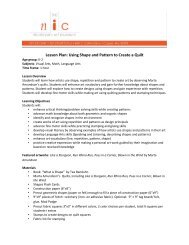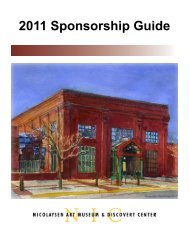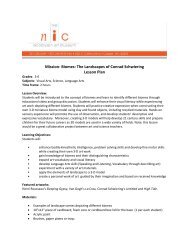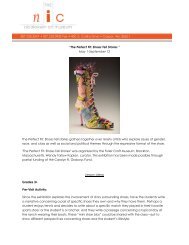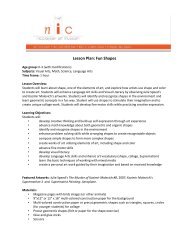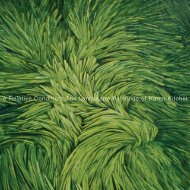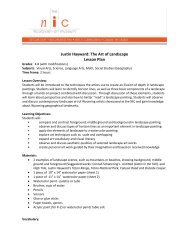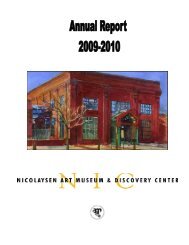Richard Renaldi - The Nicolaysen Art Museum
Richard Renaldi - The Nicolaysen Art Museum
Richard Renaldi - The Nicolaysen Art Museum
Create successful ePaper yourself
Turn your PDF publications into a flip-book with our unique Google optimized e-Paper software.
<strong>Richard</strong> <strong>Renaldi</strong><br />
Western Lives
<strong>Richard</strong> <strong>Renaldi</strong><br />
Western Lives<br />
<strong>The</strong> <strong>Nicolaysen</strong> <strong>Art</strong> <strong>Museum</strong><br />
Casper, Wyoming
<strong>Richard</strong> <strong>Renaldi</strong><br />
Western Lives<br />
Published in conjunction with the exhibition organized by<br />
<strong>The</strong> <strong>Nicolaysen</strong> <strong>Art</strong> <strong>Museum</strong>, Casper, Wyoming<br />
September 14 - December 30th, 2007<br />
Curated by Lisa Hatchadoorian<br />
This exhibition is sponsored in part by:<br />
<strong>The</strong> True Family Foundation<br />
and<br />
©<strong>The</strong> <strong>Nicolaysen</strong> <strong>Museum</strong> of <strong>Art</strong>, 2007<br />
©Images, <strong>Richard</strong> <strong>Renaldi</strong><br />
© Essay, Lisa Hatchadoorian, 2007<br />
ISBN 978-0-9798485-0-6<br />
<strong>The</strong> <strong>Nicolaysen</strong> <strong>Art</strong> <strong>Museum</strong><br />
400 East Collins Drive<br />
Casper, Wyoming 82601<br />
www.thenic.org<br />
Printed in Canada by Friesens
Acknowledgements<br />
Holly Turner, Executive Director<br />
<strong>The</strong> <strong>Nicolaysen</strong> <strong>Art</strong> <strong>Museum</strong><br />
<strong>The</strong> beautiful, insightful, and poignant photographic<br />
portraits by <strong>Richard</strong> <strong>Renaldi</strong> convey a universe in a<br />
single moment. <strong>The</strong>y are deeply empathetic to our<br />
shared human condition, as well as documenting<br />
liveslivedincertainplaces:theexpansiveandmythological<br />
West, the Great Plains region, and the Navajo Nation<br />
in Arizona. Our deepest appreciation and thanks go<br />
totheartistforhelpinginallwaystomakethisexhibition,<br />
Western Lives, a reality.<br />
<strong>Richard</strong> <strong>Renaldi</strong>: Western Lives, reaffirms the<br />
commitment of the <strong>Nicolaysen</strong> <strong>Art</strong> <strong>Museum</strong> as a<br />
venue to educate, stimulate, and promote the<br />
understanding of art so that people can meet, view,<br />
study, create and enjoy contemporary art of the<br />
Rocky Mountain Region. A special thank you goes<br />
to Curator, Lisa Hatchadoorian for spearheading<br />
this project and bringing this thought-provoking and<br />
impressive body of work to the location of its subjects.<br />
This exhibition would not have been possible without<br />
the great assistance and generosity of a number of<br />
people and organizations. We are very appreciative of<br />
the support from Yossi Milo Gallery, NY for aiding<br />
in the gathering and lending of key artworks. Major<br />
support for the exhibition and catalog was<br />
provided by the McMurry Foundation, the Wyoming<br />
Community Foundation, the Wyoming <strong>Art</strong>s Council,<br />
theCasperStar-Tribune,andtheTrueFamilyFoundation.<br />
We repeatedly thank these generous sponsors for<br />
their continued support of contemporary art of and<br />
about the Rocky Mountain Region. <strong>The</strong>y are indeed<br />
the most giving of benefactors. Through them, our<br />
communities and cultural life are enriched by<br />
their appreciation of diverse artwork that speaks<br />
to the many different and compelling aspects of<br />
contemporary existence.<br />
4
<strong>Richard</strong> <strong>Renaldi</strong><br />
Western Lives<br />
American culture has become singularly obsessed by<br />
the lurid spectacle surrounding the banal mechanics of<br />
everyday life. Through endless reality-based television,<br />
behind-the-scenes exposés on the inner torments and<br />
tantrums of notorious celebrities, there seems to be a<br />
boundless need to be filled in looking at the foibles and<br />
differences of others while comparing them to ourselves and<br />
our daily, predictable routines. What should be private is<br />
played out in public in a continuous visual loop. Much of this<br />
culture glut is an obvious overload of images needing to<br />
processed, sorted, and forgotten. Who has time to look at<br />
others, to really look, when surface and quick judgments<br />
of people are all that matters in such a world Difference,<br />
whether cultural, racial, or political, is cause for extreme<br />
divisiveness rather than the opposite of looking for<br />
common ground in order to bridge perceived gaps. In the<br />
end, it is quite quaint and homespun in its simplicity—we<br />
really are all human underneath and worth stopping to<br />
gaze at to really see and acknowledge. Maybe there is a<br />
storythere,somethingoutsideournarrowrealmofexperience<br />
that will cause us to open up and stretch our boundaries<br />
to possibly connect with another. Beyond that, what is<br />
there that is most precious and worth striving for<br />
5
6<br />
Sean Thomas, Beulah, North Dakota, 2006
7<br />
Terri, Laramie, Wyoming, 2005
<strong>The</strong> mesmerizing photographic portraits of <strong>Richard</strong> <strong>Renaldi</strong> do<br />
indeed stop us in our tracks as they force us to see beyond the<br />
outwardly mundane scrim of yet another anonymous persona<br />
to something more poignant, strong, fierce, unique, and human<br />
underneath. <strong>Renaldi</strong>, like many photographers before him<br />
(Walker Evans, Garry Winogrand, Stephen Shore), has made<br />
thatveryAmericantrekacrossthecountry,constantlyphotographing<br />
its populace and exploring their physical and spiritual ties to<br />
culture,land,home,geography,andplace. Hisrecentphotographs<br />
of well-heeled Madison Avenue pedestrians and peoples living<br />
in the West and Great Plains are imbued by the individual, their<br />
unique quirks and qualities that tend to blossom and transfix<br />
us under his lens. Whether it is a small boy dressed in the<br />
full, weighty, grubby padding of a football uniform or a waitress<br />
brandishing her mop like a lance and armored in a decorative<br />
padded apron, we experience the full force of their common,<br />
shared humanity in grinding out a life where things do not<br />
come easy. This artist is less interested in the mechanics and<br />
dynamics of the group. He tends to focus on the solitary<br />
individual or twosome, captured in their well-worn everyday<br />
environments. His photographs speak equally in revealing<br />
personal and archetypal vulnerabilities and strengths, as<br />
well as evoking a vast sense of place that, like his subjects,<br />
is both infinite, extraordinarily fascinating, prosaic, and<br />
daunting to grasp.<br />
8
8<br />
Ty James, Tuba City, Arizona, 2004
9<br />
Erica, Alliance, Nebraska, 2005
<strong>The</strong>exhibition “<strong>Richard</strong><strong>Renaldi</strong>:WesternLives,”isacombination<br />
of three different photographic projects from 2004-2006:<br />
<strong>The</strong> Great Plains, Bus Travelers, and Navajo Nation.<br />
<strong>The</strong> impetus and spark behind all three is the same in<br />
that <strong>Renaldi</strong> photographs people of all ages and walks of<br />
life through a vast stretch of the country that is probably<br />
considered off the radar in terms of the urban centers on<br />
each coast. He also tends to focus somewhat on closed<br />
communities,asleastinthetemporary—therandomgatherings<br />
of disparate folks in bus terminals, residents of small towns<br />
in the middle of the Great Plains or the various peoples<br />
comprising the Navajo Nation of Arizona. <strong>Renaldi</strong>’s<br />
forthright presentation of his subjects, mostly centered<br />
within the image and straight forwardly facing the camera,<br />
telegraph a certain confidence in who they are, how they<br />
presentthemselvestotheworld,andwhattheirexpectations are<br />
from this particular weighted interaction. For the most<br />
part, the personae of these three series are embedded in<br />
the localesandvaststretchesofthecountrythatareasforgettable,<br />
numbing, and anonymous to some as they are beautiful,<br />
extraordinary, stark, and gorgeous to others.<br />
10
11<br />
Scott, Laramie, Wyoming, 2005
12<br />
Ernest, Denver, Colorado. 2005
13<br />
Jeff, Dixie National Forest, Utah, 2004
<strong>Renaldi</strong>encapsulatesandoffersamostpreciousintimacywithhis<br />
subjects. <strong>The</strong>y reveal themselves to him and to us in the<br />
fraughtinteractionthatphotographycreatesbetweensubject,<br />
artist, and viewer. This relationship combines a certain<br />
voyeurism on the part of the viewer with the anonymity<br />
and intense intimacy between subject and artist that exists<br />
for a short-lived moment. <strong>The</strong>re is no attempt on the part<br />
of the artist or subject to implicitly dramatize or heroicize<br />
their situation, even though the images are staged and<br />
planned with full participation on both sides. <strong>The</strong>y do not<br />
look as such, which makes all the difference. <strong>The</strong> process<br />
by which <strong>Renaldi</strong> creates this work is more cumbersome<br />
and time-consuming than the images implicitly convey. <strong>The</strong><br />
photographs are composed to look like the subjects were<br />
just happened upon and snapped in an instant. <strong>The</strong> 8 x<br />
10 Wisner camera that <strong>Renaldi</strong> sets up with the tripod is<br />
cumbersome and oversized, with the entire process and<br />
interaction sometimes taking up to ten minutes to complete.<br />
His subjects must be willing to then play an equal and lengthy<br />
part in this charged act of communication and reciprocity.<br />
14
15<br />
Mike, Laughlin, Nevada, 2004
<strong>Renaldi</strong> juxtaposes these studied, thoughtful portraits within<br />
a setting that is not just a backdrop, but an extension of the<br />
person. In a sense, thisequatesthesepeopleintheirexpressive<br />
vulnerabilityandfrankpresentationwiththeanxiousfeelingarising<br />
from an encounter with an overpowering, sublime, endless<br />
expanse of nature that cannot be fully known or grasped.<br />
In capturing the gravity and interior qualities of his subjects,<br />
whilepersuadinghissitterstopresentthemselves as they are,<br />
both artist and subject transcend the moment and medium.<br />
This turns the interaction into an endless foray into memory,<br />
narrative,adventure,fantasy,andemotion.<strong>The</strong>re is no theatricality<br />
or grandstanding in <strong>Renaldi</strong>’s portraits. His subjects are more<br />
often than not, serious and contemplative, transmitting the<br />
factthatthisinteractionisworththetimeandgravityofpurpose.<br />
What you see is what you see. Except not. Whether<br />
it is the stillness, focus, questioning, resolve, or curiosity in<br />
these people, <strong>Renaldi</strong>’s portraits unfurl and draw us into their<br />
depths, while becoming much more than the sum of their<br />
surface attraction, color, depth, texture, and composition.<br />
What is more exciting than discovering and exploring the<br />
depthsofanother,atleastinthebeginningYes,wecannavigate<br />
through recognizable traits and emotions as we are very<br />
familiar with the landmarks, as they are us. It is also the<br />
deep unknowing within that familiarity that is so resolutely<br />
compelling. A mystery resides below the surface of these<br />
people, one that gets lost and buried in daily life, as ritualized<br />
tasks and the theatrics and rhythm of the everyday take<br />
over. What is ultimately so hypnotic about these jewel-like,<br />
iconic, and charismatic portraits is that, as viewers, we can<br />
glimpse the moment that people are opening themselves<br />
up to trust another in a setting that would normally be<br />
replete with anonymity, boundaries, and the respectful<br />
and welcome distance of strangers.<br />
16
17<br />
Kevin and Larry, Highway 200, North Dakota, 2006
18<br />
Klista, Dodge City, Kansas, 2005
19<br />
Tawni, Havre, Montana, 2006
20<br />
Sharon and Shaundeen, Highway 98, Arizona, 2004
No other medium retains this kind of transfixing power to meld<br />
descriptive reality with personal fantasy and supposition. It is uniquely<br />
photographythatridesthisridgebetweenaclarifiedrealityandamysterious<br />
fiction as “a different nature opens itself to the camera than opens<br />
to the naked eye.” 1 It is almost like there are simultaneous different<br />
dimensionsoftheselfalllayeredunderneathandbeyondonebeautifully<br />
composed and colored image. It is truly a looking glass effect, as the<br />
collaborationbetweenartistandsubjecthasmodifiedandtransmogrified<br />
what we know of as real life into something both recognizable and<br />
beyond the known and seen. It can now be filled with any narrative<br />
thread from pathos, to mystery, tedium, boredom, magic, and endless<br />
possibility. Thinking back to the early beginnings of photography<br />
when it was invented in 1839, the fact that some thought that it<br />
stole the souls of its subjects might not be too far off the mark<br />
when its full power is harnessed and put forth. Some essential part<br />
of these people are now out in the public realm, working on us as<br />
we gaze back at them. We think that we know and can connect<br />
with them, as well as see something of ourselves in them, when it<br />
is really only solvents and paper mixing in an alchemical combination.<br />
What indeed are we looking at and interacting with on such a deep,<br />
personal level when confronted with these people and images<br />
1 Benjamin, Walter, “<strong>The</strong> Work of <strong>Art</strong> in the Age of Mechanical Reproduction,” in Illuminations: trans. Harry<br />
Zohn (New York: 1969), 236-37: quoted in Holger Liebs, “<strong>The</strong> Same Returns: <strong>The</strong> Tradition of Documentary<br />
Photography,” in Veronica’s Revenge: Contemporary Perspectives on Photography, ed. Elizabeth Janus (New<br />
York: Scalo, 1998), 102.<br />
21
Each medium of art is intrinsically tied to its nature and it<br />
is the nature of photography to depict—in glorious detail,<br />
what we can and cannot see, right in front of our eyes.<br />
<strong>The</strong> notion of photography as an unbiased recorder of<br />
fact and reality has been methodically stripped away, but<br />
there is still the rote reality of its mechanical process that<br />
interacts with the motives of artist, subject, and viewer.<br />
Since its inception in the early 19th century, photography<br />
has strived to be taken seriously as a fine art form. <strong>The</strong><br />
fact that it was not of the hand and was considered a very<br />
democratic medium made acceptance a long, hard battle.<br />
Painting, with its sensual surface, cult of the genius artist<br />
with the oversized ego and personality went hand in<br />
hand with established painterly pictoral conventions that<br />
influencedandhamstrungphotography from the beginning.<br />
Chiefamongthiswasthetableau, “thatindependentlybeautiful<br />
depiction and composition that derives from the<br />
institutionalization of perspective and dramatic figuration...<br />
it is known as a product of divine gift, high skill, deep<br />
emotion, and crafty planning.” 2 In its infancy, photography<br />
could only present its surface as what it was. It had no<br />
gooey, thick substance to play around with, so a reliance<br />
on painterly conventions to compose the picture only<br />
went so far. Photography, though could play its own tricks<br />
with the surface, utilizing the “close-up, blow-up, depth of<br />
field, precision of detail [to open up] spaces that previously<br />
existed in dreams...buthadcertainlyneverbeenconsciouslyseen,<br />
let alone reproduced.” 3 It could take reality, such as it was,<br />
and make it more so.<br />
2 Jeff Wall, “Marks of Indifference: Aspects of Photography in, or as, Conceptual <strong>Art</strong>,” in Veronica’s<br />
Revenge: Contemporary Perspectives on Photography, ed. Elizabeth Janus (New York: Scalo, 1998), 75.<br />
3 Holger Liebs, ”<strong>The</strong> Same Returns: <strong>The</strong> Tradition of Documentary Photography,” in Veronica’s<br />
Revenge: Contemporary Perspectives on Photography, ed. Elizabeth Janus, (New York, Scalo, 1998), 102.<br />
22
23<br />
Darlene, Alliance, Nebraska, 2005
Alfred, Benny, James, and Shone, Many Farms, Arizona, 2004<br />
24
Russell, Ricky, and Joey, Rapid City, South Dakota, 2005<br />
25
<strong>Renaldi</strong>’s portraits are not objective studies on the sociology<br />
of place or a rigid categorization of a certain subculture. <strong>The</strong>y are<br />
highlysubjectiveandsuggestiveofrealmsofpersonalityimbuedby<br />
their rather stark surroundings. <strong>The</strong>re is a surprising candor about<br />
the portraits as these strangers, enticed by the photographer,<br />
have opened up their lives to us for all sorts of judgments and<br />
emotions: aesthetic pleasure, derision, boredom, fascination,<br />
and quite possibly feeling nothing at all. <strong>The</strong> tension and persuasive<br />
quality of the images rewards repeat exploring and arises<br />
from being both timeless and of the moment simultaneously.<br />
<strong>The</strong> performative aspect of portraiture is especially compelling<br />
in <strong>Renaldi</strong>’s body of work as it is subtle and below the radar.<br />
How much control do his subjects ultimately have in crafting<br />
their impression—they are not professionals, primping and<br />
pouting for an adoring camera. <strong>The</strong>y are like us, going about<br />
mundane routines when someone stops to take a brief interest<br />
in their life. How do you prepare for that moment <strong>Renaldi</strong>’s<br />
eye and camera captures the infinitesimal gestures and<br />
unconscious body language that transmits so much with so<br />
little. A balled or clenched fist, cocked tilt of head, or steely<br />
gaze all resonate on many levels. It is interesting to note that the<br />
more these portraits are looked at, the more that the clothing<br />
on <strong>Renaldi</strong>’s subjects tends to morph into costume or armor,<br />
masking what the face and body betray through the intense<br />
shared intimacy. Mass culture has us running around like<br />
maniacs all the time, trying and buying things to be people that<br />
we feel we are entitled to be in the ultimate search for the self.<br />
All choice aspects of culture:clothing,food,andmusicfunnelusintoa<br />
certain subsection and there we stay, striving to be unique within<br />
these anonymous materials and tools. Through the simple act<br />
of being aware, as well as the posing, looking, composition,<br />
and steady focus, <strong>Renaldi</strong> strips all this boring sameness away to<br />
revealnotlonging,theatre,playactingorwish-fulfillment,butenthralling,<br />
centered souls saying this is how it is with me and inviting us to look<br />
and connect on a deeper, more profound level with each other.<br />
26<br />
- Lisa Hatchadoorian, Curator
27<br />
Craig, Laughlin, Nevada, 2004
28<br />
Najiah, Denver (Denver to Los Angeles), 2005
29<br />
Jonathan and Lane, Wynnewood, Oklahoma, 2005
30<br />
John, Albuquerque, New Mexico, 2004
Checklist<br />
<strong>Richard</strong> <strong>Renaldi</strong>: Western Lives<br />
Alfred, Benny, James,<br />
and Shone<br />
Many Farms, AZ, 2004<br />
C-print<br />
21 x 25 inches<br />
Buba<br />
Havre, MT, 2006<br />
C-print<br />
60 x 50 inches<br />
Craig<br />
Laughlin, NV, 2004<br />
C-print<br />
60 x 50 inches<br />
Courtesy of Yossi Milo<br />
Gallery, NY<br />
Darlene<br />
Alliance, NE, 2005<br />
C-print<br />
25 x 21 inches<br />
Dennis<br />
Many Farms, AZ, 2004<br />
C-print<br />
25 x 21 inches<br />
Drew<br />
Hazen, ND, 2006<br />
C-print<br />
25 x 21 inches<br />
Erica<br />
Alliance, NE, 2005<br />
C-print<br />
25 x 21 inches<br />
Ernest<br />
Denver, CO, 2005<br />
C-print<br />
21 x 25 inches<br />
Jeff<br />
Dixie National Forest, UT,<br />
2004<br />
C-print<br />
21 x 25 inches<br />
John<br />
Albuquerque, NM, 2004<br />
C-print<br />
25 x 21 inches<br />
Jonathan and Lane,<br />
Wynnewood, OK, 2005<br />
C-print<br />
21 x 25 inches<br />
Courtesy of Yossi Milo<br />
Gallery, NY<br />
Kevin and Larry<br />
Highway 200, ND, 2006<br />
C-print<br />
21 x 25 inches<br />
Klista<br />
Dodge City, KS, 2005<br />
C-print<br />
25 x 21 inches<br />
Courtesy of Yossi Milo<br />
Gallery, NY<br />
Matt<br />
Fort Worth, TX, 2005<br />
C-print<br />
21 x 25 inches<br />
Mike<br />
Laughlin, NV, 2004<br />
C-print<br />
25 x 21 inches<br />
Najiah<br />
Denver (Denver to Los<br />
Angeles), 2005<br />
C-print<br />
21 x 25 inches<br />
Paul and Gregory<br />
Flagstaff, AZ, 2004<br />
C-print<br />
21 x 25 inches<br />
Russell, Ricky, and Joey<br />
Rapid City, SD, 2005<br />
C-print<br />
25 x 21 inches<br />
Scott<br />
Laramie, WY, 2005<br />
C-print<br />
25 x 21 inches<br />
Courtesy of Yossi Milo<br />
Gallery, NY<br />
Sean Thomas<br />
Beulah, ND, 2006<br />
C-print<br />
25 x 21 inches<br />
Sharon and Shaundeen<br />
Highway 98, AZ, 2004<br />
C-print<br />
21 x 25 inches<br />
Tawni<br />
Havre, MT, 2006<br />
C-print<br />
25 x 21 inches<br />
Courtesy of Yossi Milo<br />
Gallery, NY<br />
Tayla H.<br />
Parker, AZ, 2004<br />
C-print<br />
60 x 50 inches<br />
Terri<br />
Laramie, WY, 2005<br />
C-print<br />
21 x 25 inches<br />
Ty James<br />
Tuba City, AZ, 2004<br />
C-print<br />
25 x 21 inches<br />
Unless otherwise noted, all artworks are courtesy of the artist<br />
31
<strong>Richard</strong> <strong>Renaldi</strong><br />
Selected Resumé<br />
Solo Exhibitions<br />
Yossi Milo Gallery, NY, NY. 2007<br />
Western Project, Los Angeles, CA. January 2005<br />
Debs and Co, NY, NY. 2003 Fresno/Newark<br />
Debs and Co, NY, NY. 2002 Project Room - Madison Avenue Portraits<br />
Group Exhibitions<br />
PowerHouse Arena , New York, NY. 2007 <strong>The</strong> Brooklynites<br />
<strong>The</strong> Department of Photography & Imaging, New York, NY. 2007 Transformations<br />
Derek Eller , New York, NY. 2007 NeoIntegrity<br />
Western Project, Los Angeles, CA. 2004 In-A-Gadda-Da-Vida, Baby<br />
International Cener of Photography, NY, NY. 2003 Fall Triennial<br />
Yossi Milo Gallery, NY, NY. 2003 By the Sea<br />
<strong>The</strong> United Nations, NY, NY. 2002/2003 Pandemic AIDS<br />
Riva Gallery, NY, NY. 2002 Staged/Unstaged<br />
Gracie Mansion Gallery, NY, NY. 2000 Monster<br />
U.S. Conference on AIDS, Denver, CO. 1999 Housing is Healthcare<br />
Milton J. Weill <strong>Art</strong> Gallery, NY, NY. 1997 In Search of Promise, Immigration in America<br />
Feature Gallery, NY, NY. 1995 <strong>The</strong> Moderns<br />
Pulse <strong>Art</strong>, NY, NY. 1995 Self-Identified<br />
Paul Morris Gallery, NY, NY. 1995 Benefit for <strong>The</strong> Hetrick Martin Institute<br />
494 Gallery, NY, NY. 1994 Breakthroughs: Stonewall<br />
Education<br />
New York University, New York, NY September 1986 - May 1990<br />
Bachelor of Fine <strong>Art</strong>s in Photography<br />
Salzburg College, Salzburg, Austria August 1988 - May 1989<br />
Awards & Grants<br />
Peter S Reed Foundation: Grant Awarded 2004<br />
Published Works<br />
<strong>Richard</strong> <strong>Renaldi</strong>: Figure and Ground - Aperture Fall 2006<br />
<strong>Art</strong> Photography Now: Susan Bright – Aperture Spring 2006<br />
Strangers: <strong>The</strong> First ICP Triennial of Photography and Video – Steidl 2003<br />
Pandemic Facing AIDS – Umbrage 2003<br />
32
ISBN: 978-0-9798485-0-6<br />
<strong>Nicolaysen</strong> <strong>Art</strong> <strong>Museum</strong><br />
400 East Collins Drive<br />
Casper, WY 82601 USA<br />
www.thenic.org




